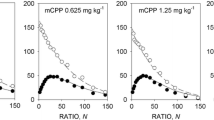Abstract
Nineteen rats received injections of 5,7-dihydroxytryptamine into the dorsal and median raphe nuclei; 16 rats received sham injections. The rats underwent 50 daily training sessions under an interresponse-time-greater-than-15-seconds (IRT >15 s) schedule of sucrose reinforcement. The lesioned group showed impaired acquisition of temporal differentiation, in that their response rates remained significantly higher and their obtained reinforcement frequencies significantly lower than those of the control (sham-lesioned) group. Comparison of the IRT frequency distributions obtained from the two groups during the last 5 days of training showed that the lesioned group produced a significantly higher proportion of very short IRTs (<3 s) than the control group; when these short IRTs were disregarded, the lesioned group displayed a significantly lower mean IRT and a significantly higher coefficient of variation than the control group. The levels of 5-hydroxytryptamine (5HT) and 5-hydroxyindoleacetic acid in the parietal cortex, hippocampus, amygdala, nucleus accumbens and hypothalamus were markedly reduced in the lesioned group, but the levels of noradrenaline and dopamine were not significantly affected by the lesion. The results suggest that destruction of the ascending 5HTergic pathways may reduce animals' capacity to inhibit positively reinforced operant behaviour, and may impair temporal discrimination.
Similar content being viewed by others
References
Altman HJ, Normile HJ (1988) What is the nature of the role of serotonergic nervous system in learning and memory: prospects for development of an effective treatment strategy for senile dementia. Neurobiol Aging 9:627–638
Altman HJ, Normile HJ, Galloway MP, Ramirez A, Azmitia EC (1990) Enhanced spatial discrimination learning in rats following 5,7-DHT-induced serotonergic deafferentiation of the hippocampus. Brain Res 518:61–66
Asin KE, Fibiger HC (1984) Spontaneous and delayed spatial alternation following damage to specific neuronal elements within the nucleus medianum raphe. Behav Brain Res 13:241–250
Barratt ES (1983) The biological basis of impulsiveness: the significance of timing and rhythm disorders. Person Indiv Diff 4:387–391
Baumgarten HG, Jenner S, Bjorklund A, Klemm HP, Schlossberger HG (1982) Serotonin neurotoxins. In: Osborne NN (ed) Biology of serotonergic transmission. Wiley, Chichester
Bizot JC, Thiebot MH, LeBihan C, Soubrie P, Simon P (1988) Effects of imipramine-like drugs and serotonin uptake blockers on delay of reward in rats. Possible implication in the behavioral mechanism of action of antidepressants. J Pharmacol Exp Ther 246:1144–1151
Bradshaw CM, Szabadi E, Ruddle HV, Pears E (1983) Herrnstein's equation: effect of deprivation level on performance in variable-interval schedules. Behav Anal Lett 3:267–273
Canon JG, Lippa AS (1977) Use of DRL in differentiating anxiolytic and neuroleptic properties of CNS drugs. Pharmacol Biochem Behav 6:591–594
Dantzer R (1977) Behavioural effects of benzodiazepines: a review. Biobehav Rev 1:71–86
Deakin JFW (1983) Roles of serotonergic systems in escape, avoidance and other behaviours. In: Cooper SJ (ed) Theory in psychopharmacology, vol 2. Academic Press, New York
Gerson SC, Baldessarini RJ (1980) Motor effects of serotonin in the central nervous system. Life Sci 27:1435–1451
Harzem P (1969) Temporal discrimination. In: Gilbert RM, Sutherland NS (eds) Animal discrimination learning. Academic Press, London
Heffner TG, Hartman JA, Seiden LS (1980) A method for the regional dissection of the rat brain. Pharmacol Biochem Behav 13:453–456
Heyman GM, Monaghan MM (1987) The effect of changes in the response requirement and deprivation on the parameters of the matching law: new data and review. J Exp Psychol [Anim Behav Proc] 13:384–394
Kelleher RT, Fry W, Cook L (1959) Interresponse time distribution as a function of differential reinforcement of temporally spaced responses. J Exp Anal Behav 2:91–106
McGuire PS, Seiden LS (1980) The effects of tricyclic antidepressants on performance under a differential-reinforcement-of-low-rates schedule in rats. J Pharmacol Exp Ther 214:635–641
Mele PC, Caplan MA (1980) Effects of cinanserin and p-chlorophenylalanine and their interaction withd-amphetamine on DRL performance in rats. Pharmacol Biochem Behav 12:883–891
O'Donnell JM, Seiden LS (1983) Differential-reinforcement-of-low-rate 72-seconds schedule: selective effects of antidepressant drugs. J Pharmacol Exp Ther 224:80–88
Ogren S-O (1985) Central serotonin neurones in avoidance learning: interactions with noradrenaline and dopamine neurones. Pharmacol Biochem Behav 23:107–123
O'Hare E, Tierney KJ, Shephard RA (1991) Cyclic-ratio schedule analysis of a serotonin agonist and depletor on consummatory behaviour. Physiol Behav 49:331–334
Paxinos G, Watson C (1982) The rat brain in stereotaxic coordinates. Academic Press, New York
Platt JR (1979) Temporal differentiation and the psychophysics of time. In: Zeiler MD, Harzem P (eds) Advances in analysis of behaviour, vol 1: Reinforcement and the organization of behaviour. Wiley, Chichester
Reynolds GS (1964) Temporally spaced responding by pigeons: development and effects of deprivation and extinction. J Exp Anal Behav 7:415–421
Sanger DJ, Blackman DE (1975) The effects of tranquilizing drugs on timing behaviour in rats. Psychopharmacologia 44:153–156
Soubrie P (1986) Reconciling the role of central serotonin neurons in human and animal behavior. Behav Brain Sci 9:319–364
Thiebot MH, Le Bihan C, Soubrie P, Simon P (1985) Benzodiazepines reduce the tolerance to reward delay in rats. Psychopharmacology 86:147–152
van den Broek MD, Bradshaw CM, Szabadi E (1987) Behaviour of “impulsive” and “non-impulsive” humans in a temporal differentiation schedule of reinforcement. Person Indiv Diff 8:233–239
van den Broek MD, Bradshaw CM, Szabadi E (1992) Performance of impulsive and non-impulsive subjects on two temporal differentiation tasks. Person Indiv Diff 13:169–174
Wearden JH (1990) Maximizing reinforcement rate on spaced-responding schedules under conditions of temporal uncertainty. Behav Proc 22:47–60
Wogar MA, Bradshaw CM, Szabadi E (1991) Evidence for an involvement of 5-hydroxytryptaminergic neurones in the maintenance of operant behaviour by positive reinforcement. Psychopharmacology 105:119–124
Zeiler MD (1977) Schedules of reinforcement, the controlling variables. In: Honig WK, Staddon JER (eds) Handbook of operant behavior. Prentice Hall, Englewood Cliffs, NJ
Zeiler MD (1981) Model of temporal differentiation. In: Bradshaw CM, Szabadi E, Lowe CF (eds) Quantification of steady-state operant behaviour. Elsevier, Amsterdam
Author information
Authors and Affiliations
Rights and permissions
About this article
Cite this article
Wogar, M.A., Bradshaw, C.M. & Szabadi, E. Impaired acquisition of temporal differentiation performance following lesions of the ascending 5-hydroxytryptaminergic pathways. Psychopharmacology 107, 373–378 (1992). https://doi.org/10.1007/BF02245164
Received:
Revised:
Issue Date:
DOI: https://doi.org/10.1007/BF02245164



